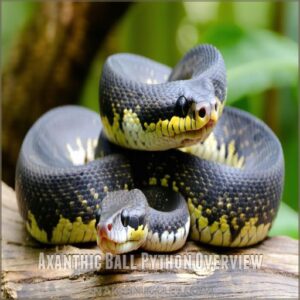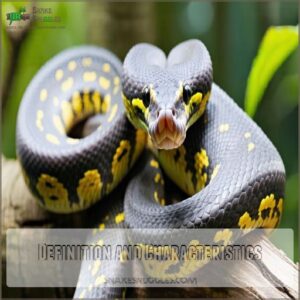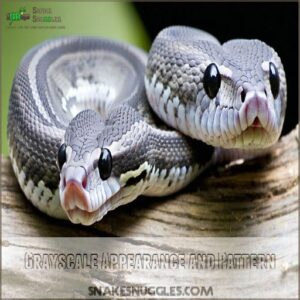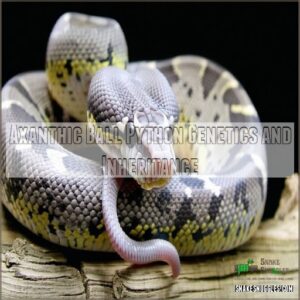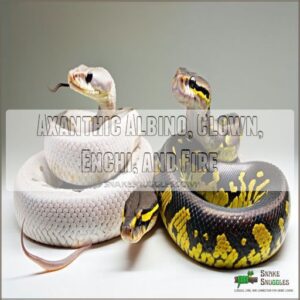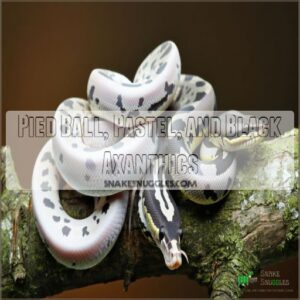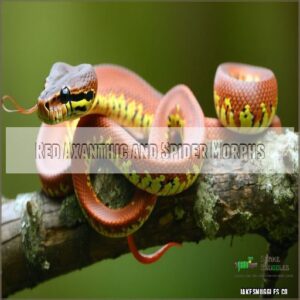This site is supported by our readers. We may earn a commission, at no cost to you, if you purchase through links.
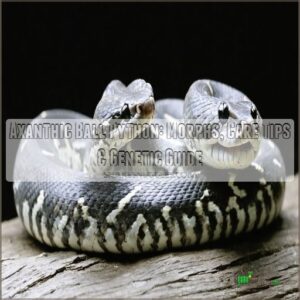 Looking for a truly unique pet?
Looking for a truly unique pet?
The axanthic ball python might just be your new favorite scaly friend.
Unlike their colorful counterparts, these snakes showcase a gorgeous grayscale palette because they lack yellow pigments, giving them an elegant, noir look.
Now, before you think they’re just black-and-white, imagine them as nature’s way of creating a living, breathing black-and-white movie.
Genetically, they possess a recessive gene that makes their striking appearance possible.
But owning one isn’t just about admiration—there’s plenty to learn about their care.
Stick around to uncover tips for keeping these monochrome marvels happy and healthy in your home.
Table Of Contents
- Key Takeaways
- Axanthic Ball Python Overview
- What is an Axanthic Ball Python?
- Axanthic Ball Python Genetics and Inheritance
- Popular Axanthic Ball Python Combinations and Morphs
- Caring for an Axanthic Ball Python
- Axanthic Ball Python Health Concerns and Care
- Owning an Axanthic Ball Python: Legality and Considerations
- Frequently Asked Questions (FAQs)
- What is an axanthic ball python?
- What is the most sought after ball python morph?
- What is axanthic?
- What does het axanthic mean?
- How to breed incompatible axanthic lines successfully?
- What are common misconceptions about axanthic ball pythons?
- How does axanthism impact python behavior?
- Are there axanthic morphs in other species?
- What are ethical considerations for breeding axanthics?
- Conclusion
Key Takeaways
- You’ll find axanthic ball pythons stunning due to their lack of yellow pigment, resulting in a striking grayscale appearance.
- Breeding axanthic ball pythons requires understanding recessive genetics and compatible bloodlines to avoid complications.
- Providing the right enclosure, temperature, humidity, and diet is crucial for your axanthic ball python’s health and well-being.
- Before getting one, you must research and comply with local laws and regulations regarding owning exotic pets, and commit to their long-term care.
Axanthic Ball Python Overview
Axanthic Ball Pythons catch your eye with their striking black, gray, and white colors due to the lack of yellow pigment.
This morph, which requires both parents to carry the recessive gene, offers a variety of patterns and unique lineage combinations.
Appearance and Genetics
Axanthic Ball Pythons captivate with their mesmerizing grayscale appearance, standing out in the diverse world of ball python morphs.
The absence of yellow, orange, and red pigments gives them a striking look shaped by their recessive genetics.
- Expect a unique black, white, and gray color palette.
- Breeding requires both parents to carry the axanthic gene.
- Incompatible lines can complicate breeding efforts.
History and Origins
Ball python enthusiasts, explore the fascinating tale of the Axanthic Ball Python‘s origins, unraveling like a mystery novel.
Discovered in Africa, these pythons sparked interest with their unique charm.
In 1991, VPI secured the first Axanthic specimen, fueling excitement about its recessive gene traits.
This genetic jackpot laid the foundation for future morph development.
Their grayscale beauty set the stage for exploring the wonders of ball python genetics.
Bloodlines and Morphs
You’re diving into the fascinating world of Axanthic bloodlines.
Each line, like VPI or Jolliff, has its unique color variations and morph combinations.
These Ball Python Morphs, including the popular albino ball python with its striking lack of melanin, offer enchanting shades, but breeding ethics demand attention to genetic diversity.
In this vibrant community, understanding your snake’s bloodline can make all the difference.
Connect with other enthusiasts, share stories, and explore this enchanting reptile world together!
What is an Axanthic Ball Python?
An Axanthic Ball Python is a unique color morph that lacks yellow pigments, creating a striking grayscale pattern.
It inherits its appearance from a recessive gene that makes it look like a living black-and-white photograph.
Definition and Characteristics
So, you’re curious about axanthic ball pythons?
These snakes are a unique result of genetic variation, showcasing the incredible diversity within this species as seen in various Ball Python Morphs. These snakes are a unique ball python morph, showcasing a fascinating change in their coloration.
The axanthic trait, a recessive gene, is responsible for this altered appearance.
It’s all about the genetics!
Think of it as a naturally occurring change in their pigmentation.
This morph lacks the usual yellows and oranges, creating a striking look.
Several bloodlines exist, like VPI, each with subtle variations in their appearance.
Breeding these snakes can be tricky due to incompatible lines, making the axanthic morph particularly interesting to reptile enthusiasts.
Grayscale Appearance and Pattern
Imagine you’ve got an Axanthic Ball Python slinking silently through its enclosure.
Its grayscale appearance is mesmerizing, with shades of silver and charcoal creating a striking camouflage canvas.
Each scale paints a unique story, blending seamlessly into a pattern that showcases nature’s artistry.
These variations aren’t random but linked to bloodline differences and morph combinations, making each python distinct in the realm of ball python morphs.
Those looking to own one of these stunning creatures can find a variety of Axanthic Ball Python morph products and accessories Axanthic Ball Python Products.
Lack of Yellow Pigment and Unique Features
Axanthic Ball Pythons lack the xanthophores responsible for yellow pigmentation, giving them a distinct grayscale look.
This absence of color variation lets the axanthic morph blend into environments like a ball python ninja.
While albino Axanthics might face breeding challenges due to genetics, unique combinations like Axanthic Enchi showcase fascinating patterns.
These snakes are intriguing study subjects, revealing the wonders of melanin in ball python morphs.
Axanthic Ball Python Genetics and Inheritance
Understanding Axanthic Ball Python genetics involves recognizing a recessive pattern of inheritance, where both parents must carry the gene for it to appear in offspring.
Homozygous and heterozygous combinations are key to understanding breeding challenges with incompatible lines.
Pattern of Inheritance and Recessive Gene
Understanding the pattern of inheritance for the Axanthic ball python involves recessive genes.
For the Axanthic trait to show, both parents must be homozygous for that gene, otherwise known as carrying the VPI gene.
When only one parent is heterozygous, meaning they carry just one copy, their offspring might carry but not express the trait.
Gene expression determines color variations in ball python combinations.
Incompatible Lines and Breeding Complications
With Axanthic ball pythons, breeders often face breeding challenges due to incompatible lines. Here’s the gist:
- Different Lines: Key Axanthic lines like VPI, TSK, and Jolliff can’t mix genetically, complicating line preservation.
- Genetic Compatibility: You’ll need two compatible Axanthic lines for successful breeding.
- Breeding Complications: Mixing incompatible lines leads to normal-looking pythons carrying hidden genes.
- Focus on Compatibility: Stick to one line for consistent morph development.
Homozygous and Heterozygous Axanthic Pythons
Breeding axanthic ball pythons might feel like juggling cats, but it boils down to recessive genetics.
Homozygous axanthic snakes have two axanthic genes, flaunting their grayscale elegance.
Heterozygous ones carry one axanthic gene but look normal.
For striking visuals, both parents need to be homozygous.
Genetic testing and understanding lineage tracing can prevent breeding complications and guarantee your future hatchlings are true-to-color marvels.
Popular Axanthic Ball Python Combinations and Morphs
You’ll discover many interesting combinations of the axanthic gene with other ball python morphs.
These include popular variations like Axanthic Albino, Clown, and even Spider morphs, each with unique visual characteristics.
Axanthic Albino, Clown, Enchi, and Fire
Axanthic Albino pythons, known as ‘Snow‘, are strikingly white with pale patterns. They’re an example of the high contrast levels that can be achieved through selective breeding, often paired with compatible morphs like pinstripe or spider to enhance their appearance learn more about breeding albino ball pythons.
Axanthic Clown morphs boast unique patterns and a playful look.
Enchi morphs brighten things up with more pronounced patterns.
Finally, the rare Axanthic Fire offers smoky tones, making it a collector’s gem.
Consider:
- The vibrant Axanthic Albino
- Clown’s playful pattern
- Enchi’s enhanced markings
- Rare Fire’s smoldering look
Pied Ball, Pastel, and Black Axanthics
Ever wondered why Pied Ball, Pastel, and Black Axanthics are all the rage?
These color variations keep folks intrigued.
Pied Ball Pythons flaunt striking patches of white and gray, while Pastel Ball Pythons lighten up the typical Axanthic tones.
You can find Pied Ball Python breeders and individuals selling them online, with prices available on websites like Pied Ball Python Price.
Black Axanthic Pythons dial up the contrast.
Breeding these morphs might require a bit more finesse, but their unique beauty and varying prices make them worth it.
Red Axanthic and Spider Morphs
Spider morphs add flair to your axanthic collection like sprinkles on ice cream.
Red Axanthics catch the eye with their unique coloration, enhancing the genetic palette of ball pythons.
Their genetics present exciting possibilities:
- Color Variation: Expect striking contrasts in patterns.
- Breeding Success: Pair wisely for the best offspring.
- Morphs Value: Both Red Axanthic and Spider genes boost desirability.
Caring for an Axanthic Ball Python
To care for an Axanthic Ball Python, you’ll need to provide the right enclosure size and temperature.
Make sure you’ve got the right humidity, a suitable substrate, hiding places, and a regular feeding schedule with appropriate prey items.
Enclosure Size and Temperature Requirements
Morph combinations are exciting, but let’s talk about creating a comfy habitat.
To achieve the ideal ball python enclosure, consider a spacious setup, such as 48" x 24" x 24" for adults, which allows for a temperature gradient and proper ventilation, like those described in a ball python enclosure guide. Your ball python’s enclosure size should mimic its natural space, spacious yet cozy.
Keep an eye on the temperature gradient; it’s like their weather forecast!
Use heating equipment to make sure the temperature sits between 75°F and 95°F.
This helps your axanthic ball python flourish, creating the perfect balance between Mother Nature and home.
Humidity, Substrate, and Hiding Places
Creating the perfect habitat for your Axanthic Ball Python involves balancing substrate types and humidity levels.
Choose from coconut husk, which can be purchased in bulk as a coconut husk substrate, or cypress mulch to maintain moisture.
Aim for 50-60% humidity, essential for healthy shedding.
Toss in a few cozy hiding spots like logs or hollow branches. This gives your python a sense of security, making their enclosure a comfortable haven.
Feeding Schedule and Prey Items
Feeding your axanthic ball python is simpler than you think!
A proper feeding schedule for banana ball pythons involves feeding hatchlings every 5-7 days, as outlined in banana ball python care, makes sure their nutritional needs are met.
Start with appropriately sized prey – young snakes get pinky mice, adults larger rats.
Feeding frequency depends on age and size; some eat weekly, others bi-weekly.
Frozen/thawed prey is safer than live.
Avoid overfeeding, which causes health issues.
Supplements aren’t always necessary, but a vet can advise.
Remember, consistency is key to a happy, healthy ball python.
Axanthic Ball Python Health Concerns and Care
Keeping your Axanthic Ball Python healthy involves understanding common issues like improper shedding and feeding challenges.
Regular health check-ups and adopting preventative measures can help make sure your snake stays vibrant and happy.
Improper Shedding and Feeding Issues
For axanthic ball pythons, improper shedding can often be linked to low humidity.
Make sure their environment stays around 50-60% humidity to help them shed smoothly.
You can achieve this by misting their enclosure or using a moisture-retaining substrate.
Hydration goes hand-in-hand with shedding, so always provide fresh water.
Stress is another sneaky culprit.
Make sure your axanthic ball python has a calm setting with hiding spots.
As for feeding, sometimes these snakes get finicky.
Sticking to a consistent feeding schedule and offering the right prey size can keep your snake’s health on track.
Regular Health Check-Ups and Preventative Measures
Your axanthic ball python’s health thrives on good preventative care.
Think of vet visits as a wellness check-up, a little TLC to keep them slithering smoothly.
Keep these tips in mind:
- Parasite prevention: Regular checks and treatments keep unwanted guests at bay.
- Husbandry practices: Clean, well-maintained enclosures make a happy snake.
- Stress reduction: A relaxed python is a healthy python, so minimize disruptions.
- Dietary balance: Make sure meals are nutritious and appropriately sized.
- Vet visits: Partner with a herp vet to catch and treat issues early.
Remember, good care leads to fewer scale-biting surprises!
Owning an Axanthic Ball Python: Legality and Considerations
When owning an Axanthic Ball Python, you need to check local laws to make sure keeping exotic pets is allowed.
Proper care and a commitment to the python’s needs are important for responsible ownership.
Laws and Regulations Regarding Exotic Pets
Before adding an axanthic ball python to your family, consider the legal maze of owning exotic pets, noting that some states have specific regulations or bans, such as state laws on owning venomous snakes as pets.
Some places require permits, licenses, or have strict import restrictions.
It’s like going through a jungle of laws and regulations.
Before getting an Axanthic Ball Python, research top-rated ball python breeders like Kinova, CV Exotics, and CB Reptiles, who prioritize ethical breeding practices. Chat with local wildlife authorities or ball python breeders to make sure you’re on the right path.
The goal? Responsible ownership that respects both your python and the law.
Responsible Ownership and Long-Term Commitment
Owning an Axanthic Ball Python isn’t just a walk in the park.
Think of it as having a quiet roommate who doesn’t pay rent but demands excellent care.
You’ve got to nail the enclosure setup, from temperature to hiding spots.
Regular vet care keeps your scaly buddy healthy, while the right diet guarantees a long axanthic ball python lifespan.
You’re both in this for the long haul!
Researching and Preparing for Axanthic Ball Python Care
So, you’re ready for the commitment? Awesome!
First, research your area’s laws on owning exotic pets.
An axanthic ball python’s lifespan is long; are you prepared?
Proper housing, diet, and vet care are key to their well-being.
Factor in the axanthic ball python price and ongoing costs.
Understanding axanthic ball python care, including the axanthic morph’s unique needs, is essential.
When learning about different ball python morphs, such as the banana ball python and its unique characteristics, like its light tanned orange head with faded coloration. Explore different ball python morphs and their care requirements.
Remember, responsible ownership means providing a great life.
Frequently Asked Questions (FAQs)
What is an axanthic ball python?
Imagine a ball python that forgot its paint palette.
Axanthic Ball Pythons lack the usual yellows and reds, showing off sleek grays, blacks, and whites instead.
They’re a striking, recessive genetic morph that captivates enthusiasts.
What is the most sought after ball python morph?
The Pied Ball Python morph is one of the most sought-after due to its striking pattern of bold white patches contrasting with various colors.
Its unique, dramatic look captivates enthusiasts, making it a prized choice.
What is axanthic?
Axanthic refers to a genetic trait in reptiles, resulting in the absence of yellow and red pigmentation.
Instead, you’ll find animals with a striking palette of blacks, greys, and whites, giving them a unique, monochromatic appearance.
What does het axanthic mean?
A bird in the hand is worth two in the bush, so understand this: "het" means heterozygous.
You’ve got one copy of the axanthic gene; one normal, one mutant.
It’s a hidden trait, visually indistinguishable from a normal snake.
How to breed incompatible axanthic lines successfully?
To breed incompatible Axanthic lines, keep genetics in mind and pair only compatible hets.
Focus on nurturing offspring by maintaining a perfect habitat—temperature, humidity, and diet.
Patience is key, trust the process for desired traits.
What are common misconceptions about axanthic ball pythons?
Diving into axanthic myths, folks often think they’re always gray and never change.
Over time, their colors might shift to brown.
Another idea is that all axanthics look alike, but each line’s hue varies uniquely.
How does axanthism impact python behavior?
Axanthism doesn’t noticeably alter python behavior.
These pythons retain typical behaviors like hunting and hiding.
Their grayscale appearance stems from genetic pigmentation changes, not behavioral shifts, so expect them to act just like any other ball python.
Are there axanthic morphs in other species?
Yes, axanthic morphs appear in other species like axolotls, bearded dragons, iguanas, and skinks.
These creatures share the axanthism trait, which removes yellow and red pigments, creating striking grayscale appearances across diverse reptilian and amphibian species.
What are ethical considerations for breeding axanthics?
Think of breeding Axanthics like weaving a tapestry; both parents must carry the recessive gene.
Ethical implications such as genetic diversity, animal welfare, and responsible ownership should be considered.
To promote sustainable, healthy breeding practices and avoid harming these fascinating reptiles.
Conclusion
Discovering the axanthic ball python reveals a grayscale marvel, embracing elegance through its unique genetic pattern.
Balanced enclosure conditions, consistent feeding routines, and periodic health checks are essential for its care.
While its absence of yellow pigment sets it apart, your commitment to responsible ownership guarantees its well-being.
Whether you’re fascinated by its genetics or captivated by its beauty, this special snake will invite you into a world of wondrous natural discovery.

